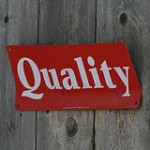Six Sigma is intended to streamline office process through eliminating defects,thereby avoiding expensive “redos” and potential lawsuits.
Six Sigma DMADV is an acronym that stands for design, measure, analyze, and verify. Total Quality Management (TQM) as applied to your workspace can have phenomenal results – if you’re willing to use some elbow grease.
At our own place of employment, what processes can be streamlined, updated, or simply modernized so that they function more efficiently? This summer, I’ve undergone course review on all three online classes I’ve developed. This process has forced me to revisit design standards, repair broken links, standardize nomenclature, ensure consistency, and provide a more organized “look and feel” that will appeal to the end user.
Organization as we commonly think of it applies to our physical space – although we seldom consider that how we perform our jobs can benefit from the same procedure. At the office, have you submitted finished product to an objective set of eyes? In my experience, a course design specialist was able to not only offer helpful tips (and send me the most up-to-datestandards), buttoact as a collaborator in the process.In a similar vein,Jack Canfield explainedthe improvement in his work flow wrought by productivity coach Martha Ringer.
I think that both pride and our willingness to “go it alone” sometimes circumvent our willingness to seek feedback. The recipients of your product however will be glad that you did. If you’re a teacher, when was the last time you updated your materials? If you work in a profession with external guidelines (e.g., law, accounting, or medicine) are you complying with the letter of the law? Have you let your continuing education credits lapse? Can you change how you structure your day so that less time is wasted, and you accomplish your most important tasks at your peak hours of performance?
External review, a course in time management, and a proper perspective on work/life balance are essential if we’re to work at full capacity. In his study of CEOS, Zig Ziglar found (interestingly) that they were not workaholics – they instead put in about 50-55 hours a week on the job. Too much work can be as disastrous as too little, which is why it’s important to eliminate excess so that we work smarter,not harder. Efficiency is about squeezing that last ounce of productivity from your workday.
Take an inventory of all the different tasks you perform. Which can be eliminated, delegated, automated, or improved? For the last category, have you developed an improvement plan? Who will be your “partner in crime” to ensure that the end product meets specifications? Make your throughput “all that it can be” and reap the benefits of a job well done.





Recent Comments